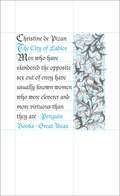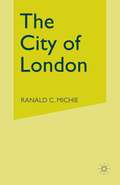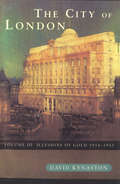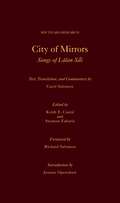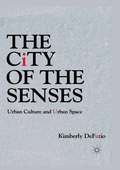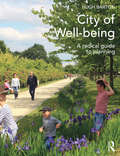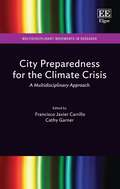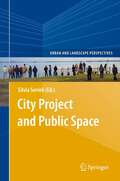- Table View
- List View
The City of Ladies: The Treasury Of The City Of Ladies (Penguin Great Ideas Ser. #Vol. 28)
by Christine De PizanThroughout history, some books have changed the world. They have transformed the way we see ourselves - and each other. They have inspired debate, dissent, war and revolution. They have enlightened, outraged, provoked and comforted. They have enriched lives - and destroyed them. Now Penguin brings you the works of the great thinkers, pioneers, radicals and visionaries whose ideas shook civilization and helped make us who we are.Pioneering female writer Christine de Pizan's spirited defence of her sex against medieval misogyny and literary stereotypes is now recognized as one of the most important books in the history of feminism, and offers a telling insight into the role of women in a man's world.
The City of London: Continuity and Change, 1850–1990
by Ronald C. MichieWhat is the City of London? The term is in everyday use but few are willing to define it. If pressed some will suggest that it means the entire UK financial sector while others point to a particular part of London - the Square Mile. Neither of these definitions is adequate because the City is both greater and less than either finance alone or a physical location. The author demonstrates that it is only by taking a detailed look at the City over the last 100 years that it can be understood.
The City Of London Volume 3: Illusions of Gold 1914 - 1945
by David KynastonIllusions of Gold, the third volume of David Kynaston's magnificent quartet, The City of London, sweeps us from 1914 to 1945, through years of fluctuating fortunes that began with the City at an all-time high, and ended with the 'Square Mile' ravaged by bombs, at its lowest ebb ever. With unerring judgement and story-telling verve, Kynaston takes us through the City's vain attempt to recover the glory days before the First World War, in the return to the Gold Standard. He follows its tussles with government over control of monetary policy, investigates its increasingly important links with British industry and gives a pioneering account of its controversial role in the politics of appeasement. Kynaston's great strength is his combination of vivid narrative with meticulous scholarship, based on an unparalleled variety of unpublished sources. The City of London is now hailed as one of the most ambitious and rewarding historical projects of recent times.
CITY OF MIRRORS C: Songs of Lalan Sai (South Asia Research)
Carol Salomon dedicated over thirty years of her life to researching, translating, and annotating this compilation of songs by the Bengali poet and mystical philosopher Lalan Sai (popularly transliterated as Lalon) who lived in the village of Cheuriya in Bengal in the latter half of the nineteenth century. One major objective of his lyrical riddles was to challenge the restrictions of cultural, political, and sexual identity, and his songs accordingly express a longing to understand humanity, its duties, and its ultimate destiny. His songs also contain thinly veiled references to esoteric yogic practices (sadhana), including body-centered Hathayogic techniques that are related to those found in Buddhist, Kaula, Natha, and Sufi medieval tantric literature. Dr. Salomon's translation of the work is the first dedicated English translation of Lalan's songs to closely follow the Bangla text, with all of its dialectical variations, and is here produced alongside the original text. Although her untimely death left her work unpublished, the editors have worked diligently to reconstruct her translations from her surviving printed and handwritten manuscripts. The result is a finished product that can finally share her groundbreaking scholarship on Baul traditions with the world.
City of My Heart: Four Accounts of Love, Loss and Betrayal in Nineteenth-Century Delhi
by Rana SafviDilli, Hindustan ka Dil… Through nuanced translations of four Urdu narratives spanning the period of turmoil that led to the Revolt of 1857, and culminated in the fall of the Mughal Empire, this compelling volume reveals the tragic and affecting story of a royalty in decline. Vividly documenting the twilight years of not just a historical era but also an entire way of life, these first-hand accounts – gleaned from princes and paupers alike – provide rare insight into how the royals and their subjects experienced life on either side of the cataclysm. Tales of suffering describe the perfidy of the British and the plight of the last royals as they are disbanded and pushed into dire poverty; livelier accounts of fealty and treachery detail palace intrigues; and nostalgic reminiscences recreate the days of past glory and communal comity – of feasting and festivals, and shared faith and devotion. An intimate chronicle of a crucial era in India’s history, City of My Heart is the saga of a changing city and a people experiencing the end of life as they know it.
City of Omens: A Search for the Missing Women of the Borderlands
by Dan WerbFor decades, American hungers sustained Tijuana. In this scientific detective story, a public health expert reveals what happens when a border city's lifeline is brutally severed.Despite its reputation as a carnival of vice, Tijuana was, until recently, no more or less violent than neighboring San Diego, its sister city across the border wall. But then something changed. Over the past ten years, Mexico's third-largest city became one of the world's most dangerous. Tijuana's murder rate skyrocketed and produced a staggering number of female victims. Hundreds of women are now found dead in the city each year, or bound and mutilated along the highway that lines the Baja coast.When Dan Werb began to study these murders in 2013, rather than viewing them in isolation, he discovered that they could only be understood as one symptom among many. Environmental toxins, drug overdoses, HIV transmission: all were killing women at overwhelming rates. As an epidemiologist, trained to track epidemics by mining data, Werb sensed the presence of a deeper contagion targeting Tijuana's women. Not a virus, but some awful wrong buried in the city's social order, cutting down its most vulnerable inhabitants from multiple directions.Werb's search for the ultimate causes of Tijuana's femicide casts new light on immigration, human trafficking, addiction, and the true cost of American empire-building. It leads Werb all the way from factory slums to drug dens to the corridors of police corruption, as he follows a thread that ultimately leads to a surprising turn back over the border, looking northward.“City of Omens is a compelling and disturbing tour of a border world that outsiders rarely see - and simultaneously, a clear guide to a field of public health that offers an essential framework for understanding how both ideas and diseases can spread.” -- MAIA SZALAVITZ, author of Unbroken Brain“Dan Werb combines his expertise as a trained epidemiologist with his keen discernment as an investigative journalist to depict what happens when poverty, human desperation, and unfathomable greed at the highest levels of a society mix with imperial ambition and a criminally ill-conceived policy towards drug use. It is a riveting and heartbreaking story, told with eloquence and compassion.” -- GABOR MATÉ, MD, bestselling author of In the Realm of Hungry Ghosts: Close Encounters with Addiction“City of Omens is an urgent and needed account of a desperate problem. The perils that Mexico's women face haunt the conscience of a nation.” -- ALFREDO CORCHADO, author of Homelands and Midnight in Mexico
City of Refuge: Separatists and Utopian Town Planning
by Michael J. LewisThe vision of Utopia obsessed the nineteenth-century mind, shaping art, literature, and especially town planning. In City of Refuge, Michael Lewis takes readers across centuries and continents to show how Utopian town planning produced a distinctive type of settlement characterized by its square plan, collective ownership of properties, and communal dormitories. Some of these settlements were sanctuaries from religious persecution, like those of the German Rappites, French Huguenots, and American Shakers, while others were sanctuaries from the Industrial Revolution, like those imagined by Charles Fourier, Robert Owen, and other Utopian visionaries.Because of their differences in ideology and theology, these settlements have traditionally been viewed separately, but Lewis shows how they are part of a continuous intellectual tradition that stretches from the early Protestant Reformation into modern times. Through close readings of architectural plans and archival documents, many previously unpublished, he shows the network of connections between these seemingly disparate Utopian settlements—including even such well-known town plans as those of New Haven and Philadelphia.The most remarkable aspect of the city of refuge is the inventive way it fused its eclectic sources, ranging from the encampments of the ancient Israelites as described in the Bible to the detailed social program of Thomas More's Utopia to modern thought about education, science, and technology. Delving into the historical evolution and antecedents of Utopian towns and cities, City of Refuge alters notions of what a Utopian community can and should be.
City of Refuge: Separatists and Utopian Town Planning
by Michael J. LewisThe vision of Utopia obsessed the nineteenth-century mind, shaping art, literature, and especially town planning. In City of Refuge, Michael Lewis takes readers across centuries and continents to show how Utopian town planning produced a distinctive type of settlement characterized by its square plan, collective ownership of properties, and communal dormitories. Some of these settlements were sanctuaries from religious persecution, like those of the German Rappites, French Huguenots, and American Shakers, while others were sanctuaries from the Industrial Revolution, like those imagined by Charles Fourier, Robert Owen, and other Utopian visionaries.Because of their differences in ideology and theology, these settlements have traditionally been viewed separately, but Lewis shows how they are part of a continuous intellectual tradition that stretches from the early Protestant Reformation into modern times. Through close readings of architectural plans and archival documents, many previously unpublished, he shows the network of connections between these seemingly disparate Utopian settlements—including even such well-known town plans as those of New Haven and Philadelphia.The most remarkable aspect of the city of refuge is the inventive way it fused its eclectic sources, ranging from the encampments of the ancient Israelites as described in the Bible to the detailed social program of Thomas More's Utopia to modern thought about education, science, and technology. Delving into the historical evolution and antecedents of Utopian towns and cities, City of Refuge alters notions of what a Utopian community can and should be.
City of Strangers: Gulf Migration and the Indian Community in Bahrain
by Andrew M. GardnerIn City of Strangers, Andrew M. Gardner explores the everyday experiences of workers from India who have migrated to the Kingdom of Bahrain. Like all the petroleum-rich states of the Persian Gulf, Bahrain hosts an extraordinarily large population of transmigrant laborers. Guest workers, who make up nearly half of the country's population, have long labored under a sponsorship system, the kafala, that organizes the flow of migrants from South Asia to the Gulf states and contractually links each laborer to a specific citizen or institution. In order to remain in Bahrain, the worker is almost entirely dependent on his sponsor's goodwill. The nature of this relationship, Gardner contends, often leads to exploitation and sometimes violence. Through extensive observation and interviews Gardner focuses on three groups in Bahrain: the unskilled Indian laborers who make up the most substantial portion of the foreign workforce on the island; the country's entrepreneurial and professional Indian middle class; and Bahraini state and citizenry. He contends that the social segregation and structural violence produced by Bahrain's kafala system result from a strategic arrangement by which the state insulates citizens from the global and neoliberal flows that, paradoxically, are central to the nation's intended path to the future. City of Strangers contributes significantly to our understanding of politics and society among the states of the Arabian Peninsula and of the migrant labor phenomenon that is an increasingly important aspect of globalization.
'City of the Future': Built Space, Modernity and Urban Change in Astana (Integration and Conflict Studies #14)
by Mateusz LaszczkowskiAstana, the capital city of the post-Soviet Kazakhstan, has often been admired for the design and planning of its futuristic cityscape. This anthropological study of the development of the city focuses on every-day practices, official ideologies and representations alongside the memories and dreams of the city’s longstanding residents and recent migrants. Critically examining a range of approaches to place and space in anthropology, geography and other disciplines, the book argues for an understanding of space as inextricably material-and-imaginary, and unceasingly dynamic – allowing for a plurality of incompatible pasts and futures materialized in spatial form.
City of the Ram-Man: The Story of Ancient Mendes
by Donald B. RedfordA richly illustrated history that sheds light on ancient Egypt across the millenniaIn this richly illustrated book, renowned archaeologist Donald Redford draws on the latest discoveries—including many of his own—to tell the story of the ancient Egyptian city of Mendes, home of the mysterious cult of the "fornicating ram who mounts the beauties." Excavation by Redford and his colleagues over the past two decades has cast a flood of light on this strange center of worship and political power located in the Nile Delta. A sweeping chronological account filled with photographs, drawings, and informative sidebars, City of the Ram-Man is the first history of Mendes written for general readers.Founded in the remote prehistoric past, inhabited continuously for 5,000 years, and abandoned only in the first-century BC, Mendes is a microcosm of ancient Egyptian history. City of the Ram-Man tells the city's full story—from its founding, through its development of a great society and its brief period as the capital of Egypt, up to its final decline. Central to the story is millennia of worship dedicated to the lascivious ram-god. The book describes the discoveries of the great temple of the ram and the "Mansion of the Rams," where the embalmed bodies of the avatars of the god were buried. It also discusses ancient Greek reports that these ram-gods occasionally ritually fornicated with women.Vividly written and informed throughout by Redford's intimate knowledge of the remains of Mendes, City of the Ram-Man is a unique account of a long-lost monument of Egyptian history, religion, and culture.
The City of the Senses: Urban Culture and Urban Space
by K. DeFazioOffers an innovative, interdisciplinary approach which opens up new ways of understanding urban culture and space. The author approaches the city as essentially a 'material' place where people live, work, and participate in social practices within historical limits set not by sensory experience or cultural meanings but material social conditions.
City of the Sharp-Nosed Fish: Greek Lives in Roman Egypt
by Prof Peter ParsonsHow an ancient rubbish dump has given us a unique view of life 2,000 years agoIn 1897 two Oxford archaeologists began digging a mound south of Cairo. Ten years later, they had uncovered 500,000 fragments of papyri. Shipped back to Oxford, the meticulous and scholarly work of deciphering these fragments began. It is still going on today. As well as Christian writings from totally unknown gospels and Greek poems not seen by human eyes since the fall of Rome, there are tax returns, petitions, private letters, sales documents, leases, wills and shopping lists. What they found was the entire life of a flourishing market-town - Oxyrhynchos ( the `city of the sharp-nosed fish' ), - encapsulated in its waste paper. The total lack of rain in this part of Egypt had preserved the papyrus beneath the sand, as nowhere else in the Roman Empire. We hear the voices of barbers, bee-keepers and boat-makers, dyers and donkey-drivers, weavers and wine-merchants, set against the great events of late antiquity: the rise and fall of the Roman Empire and the coming of Christianity. The result is an extraordinary and unique picture of everyday life in the Nile Valley between Alexander the Great in 300 BC and the Arab conquest a thousand years later.
City of Walls: Crime, Segregation, and Citizenship in São Paulo (PDF)
by Teresa CaldeiraTeresa Caldeira's pioneering study of fear, crime, and segregation in São Paulo poses essential questions about citizenship and urban change in contemporary democratic societies. Focusing on São Paulo, and using comparative data on Los Angeles, she identifies new patterns of segregation developing in these cities and suggests that these patterns are appearing in many metropolises.
City of Well-being: A radical guide to planning
by Hugh BartonCity of Well-being provides a radical and holistic introduction to the science and art of town planning. It starts from the premise that the purpose of planning is the health, well-being and sustainable quality of life of people. Drawing on current and historic examples it offers inspiration, information and an integrated perspective which challenges all professions and decision-makers that affect the urban environment. It is both authoritative and readable, designed for students, practitioners, politicians and civil society. The science. Summarizing the most recent research, the book demonstrates the interrelationships between the huge issues of obesity, unhealthy lifestyles, inequality, mental illness, climate change and environmental quality. The radical implications for transport, housing, economic, social and energy policies are spelt out. The art and politics. The book examines how economic development really happens, and how spatial decisions reinforce or undermine good intentions. It searches for the creative strategies, urban forms and neighbourhood designs that can marry the ideal with the real. The relationship of planning and politics is tackled head-on, leading to conclusions about the role of planners, communities and development agencies in a pluralistic society. Healthy planning principles could provide a powerful logical motivation for all practitioners.
City of Well-being: A radical guide to planning
by Hugh BartonCity of Well-being provides a radical and holistic introduction to the science and art of town planning. It starts from the premise that the purpose of planning is the health, well-being and sustainable quality of life of people. Drawing on current and historic examples it offers inspiration, information and an integrated perspective which challenges all professions and decision-makers that affect the urban environment. It is both authoritative and readable, designed for students, practitioners, politicians and civil society. The science. Summarizing the most recent research, the book demonstrates the interrelationships between the huge issues of obesity, unhealthy lifestyles, inequality, mental illness, climate change and environmental quality. The radical implications for transport, housing, economic, social and energy policies are spelt out. The art and politics. The book examines how economic development really happens, and how spatial decisions reinforce or undermine good intentions. It searches for the creative strategies, urban forms and neighbourhood designs that can marry the ideal with the real. The relationship of planning and politics is tackled head-on, leading to conclusions about the role of planners, communities and development agencies in a pluralistic society. Healthy planning principles could provide a powerful logical motivation for all practitioners.
A City on Mars: Can We Settle Space, Should We Settle Space, and Have We Really Thought This Through?
by Dr. Kelly Weinersmith Zach WeinersmithWINNER OF THE ROYAL SOCIETY TRIVEDI SCIENCE BOOK PRIZE 2024ONE OF THE TIMES, SUNDAY TIMES AND NEW SCIENTIST BEST SCIENCE BOOKS OF THE YEARA HUGO AWARD WINNER FOR BEST RELATED WORK 2024THE INTERNATIONAL BESTSELLERTHE #2 MOST GIFTED BOOK IN THE SOLAR SYSTEMFrom the bestselling authors of Soonish, a brilliant and hilarious off-world investigation into space settlementEarth is not well. The promise of starting life anew somewhere far, far away - no climate change, no war, no Twitter - beckons, and settling the stars finally seems within our grasp. Or is it? Bestselling authors Kelly and Zach Weinersmith set out to write the essential guide to a glorious future of space settlements, but after years of original research, and interviews with leading space scientists, engineers and legal experts, they aren't so sure it's a good idea. Space tech and space business are progressing fast, but we lack the deep knowledge needed to have space-kids, build space-farms and create space nations in a way that doesn't spark conflict back home. In a world hurtling toward human expansion into space, A City on Mars investigates whether the dream of new worlds won't create a nightmare, both for settlers and the people they leave behind.With deep expertise, a winning sense of humour and art from the beloved creator of Saturday Morning Breakfast Cereal, the Weinersmiths investigate perhaps the biggest questions humanity will ever ask itself - whether and how to become multiplanetary.
City Policies and the European Urban Agenda
by Martín Fernández-Prado Luis Domínguez CastroDuring the next few years, most European and World cities will be developing urban agendas. Materials published on the subject have been relatively scarce until now. This edited volume introduces a case study implementation of the European Urban Agenda (EUA) in a cross-border region in the Iberian Peninsula between Spain (Galicia) and Portugal. It explores the implementation of a number of urban core principles in two distinctive regions, serving as the basis for a comparative analysis on how such galvanizing principles work, contained in the EUA. The case presented in this edited volume is the first cross-border urban agenda to be drafted. It is a unique piece that contributes to our understanding of the complexities of implementing and translating a common set of urban European principles to variety of different local milieus. The chapters of the book closely examine the various strands of the implementation of urban policies through the lenses of land use, economic competition, innovation, culture and creative industries, energy, ecology, demographic challenges, housing, social inclusion and democratic governance. These chapters are written by international renowned scholars who were involved in the drawing up of the urban agenda for this territory. The ideas, principles and concepts that they impart can be extrapolated to most cities.
City Preparedness for the Climate Crisis: A Multidisciplinary Approach (Multidisciplinary Movements in Research)
Exploring the ways that contemporary urban life takes the Holocene for granted, this multidisciplinary book warns that anthropogenic environmental impacts are on course to challenge the viability of most human settlements. It highlights how, despite increased warnings, most cities appear to be in denial of the potential impending catastrophes and remain ill-prepared to handle major disruptions. Chapters offer a critical appraisal of the end of an urban epoch: the Holocene city. Moving from more general aspects of urban vulnerability in the face of the Anthropocene, the book then looks at more specific issues and cases illustrating alternative adaptation pathways. It further analyses existing approaches, movements and networks for urban preparedness for the climate crisis, offering visualisations of the ways these can be improved, conceiving alternative futures and reinventing the city. A timely resource for this emerging topic, the book will be beneficial to urban studies, environmental science and development studies scholars. Practitioners in urban planning, design, management and evaluation will also find the critical case studies in the book particularly helpful.
City Project and Public Space (Urban and Landscape Perspectives #14)
by Silvia SerreliThe book aims at nurturing theoretic reflection on the city and the territory and working out and applying methods and techniques for improving our physical and social landscapes. The main issue is developed around the projectual dimension, with the objective of visualising both the city and the territory from a particular viewpoint, which singles out the territorial dimension as the city’s space of communication and negotiation. Issues that characterise the dynamics of city development will be faced, such as the new, fresh relations between urban societies and physical space, the right to the city, urban equity, the project for the physical city as a means to reveal civitas, signs of new social cohesiveness, the sense of contemporary public space and the sustainability of urban development. Authors have been invited to explore topics that feature a pluralism of disciplinary contributions studying formal and informal practices on the project for the city and seeking conceptual and operative categories capable of understanding and facing the problems inherent in the profound transformations of contemporary urban landscapes.
City Publics: The (Dis)enchantments of Urban Encounters (Questioning Cities)
by Sophie WatsonSome cities have grown into mega cities and some into uncontrolled sprawl; others have seen their centres decline with populations moving to the suburbs. In such times, questions of the public realm and public space in cities warrant even greater attention than previously received. Concerned with the borders and boundaries, constraints and limits on accepting, acknowledging and celebrating difference in public, Sophie Watson, through ethnographic studies, interrogates how difference is negotiated and performed. Focusing on spaces where to outside observers tension is relatively absent or invisible, Watson also reveals how the boundaries between the public and private are being negotiated and redrawn, and how public and private spaces are mutually constitutive. Through her investigation of the more ordinary and less dramatic forms of encounter and contestation in the city, Watson is able to conceive an urban public realm and urban public space that is heterogeneous and potentially progressive. With numerous photographs and drawings City Publics not only throws new light on encounters with others in public space, but also destabilizes dominant, sometimes simplistic, universalized accounts and helps us re-imagine urban public space as a site of potentiality, difference, and enchanted encounters.
City Publics: The (Dis)enchantments of Urban Encounters (Questioning Cities)
by Sophie WatsonSome cities have grown into mega cities and some into uncontrolled sprawl; others have seen their centres decline with populations moving to the suburbs. In such times, questions of the public realm and public space in cities warrant even greater attention than previously received. Concerned with the borders and boundaries, constraints and limits on accepting, acknowledging and celebrating difference in public, Sophie Watson, through ethnographic studies, interrogates how difference is negotiated and performed. Focusing on spaces where to outside observers tension is relatively absent or invisible, Watson also reveals how the boundaries between the public and private are being negotiated and redrawn, and how public and private spaces are mutually constitutive. Through her investigation of the more ordinary and less dramatic forms of encounter and contestation in the city, Watson is able to conceive an urban public realm and urban public space that is heterogeneous and potentially progressive. With numerous photographs and drawings City Publics not only throws new light on encounters with others in public space, but also destabilizes dominant, sometimes simplistic, universalized accounts and helps us re-imagine urban public space as a site of potentiality, difference, and enchanted encounters.
The City Reader (Routledge Urban Reader Series)
by Richard T. LeGates Frederic StoutThe sixth edition of the highly successful The City Reader juxtaposes the very best classic and contemporary writings on the city to provide the comprehensive mapping of the terrain of Urban Studies and Planning old and new. The City Reader is the anchor volume in the Routledge Urban Reader Series and is now integrated with all ten other titles in the series. This edition has been extensively updated and expanded to reflect the latest thinking in each of the disciplinary areas included and in topical areas such as compact cities, urban history, place making, sustainable urban development, globalization, cities and climate change, the world city network, the impact of technology on cities, resilient cities, cities in Africa and the Middle East, and urban theory. The new edition places greater emphasis on cities in the developing world, globalization and the global city system of the future. The plate sections have been revised and updated. Sixty generous selections are included: forty-four from the fifth edition, and sixteen new selections, including three newly written exclusively for The City Reader. The sixth edition keeps classic writings by authors such as Ebenezer Howard, Ernest W. Burgess, LeCorbusier, Lewis Mumford, Jane Jacobs, and Louis Wirth, as well as the best contemporary writings of, among others, Peter Hall, Manuel Castells, David Harvey, Saskia Sassen, and Kenneth Jackson. In addition to newly commissioned selections by Yasser Elshestawy, Peter Taylor, and Lawrence Vale, new selections in the sixth edition include writings by Aristotle, Peter Calthorpe, Alberto Camarillo, Filip DeBoech, Edward Glaeser, David Owen, Henri Pirenne, The Project for Public Spaces, Jonas Rabinovich and Joseph Lietman, Doug Saunders, and Bish Sanyal. The anthology features general and section introductions as well as individual introductions to the selected articles introducing the authors, providing context, relating the selection to other selection, and providing a bibliography for further study. The sixth edition includes fifty plates in four plate sections, substantially revised from the fifth edition.
The City Reader (Routledge Urban Reader Series)
by Richard T. LeGates Frederic StoutThe sixth edition of the highly successful The City Reader juxtaposes the very best classic and contemporary writings on the city to provide the comprehensive mapping of the terrain of Urban Studies and Planning old and new. The City Reader is the anchor volume in the Routledge Urban Reader Series and is now integrated with all ten other titles in the series. This edition has been extensively updated and expanded to reflect the latest thinking in each of the disciplinary areas included and in topical areas such as compact cities, urban history, place making, sustainable urban development, globalization, cities and climate change, the world city network, the impact of technology on cities, resilient cities, cities in Africa and the Middle East, and urban theory. The new edition places greater emphasis on cities in the developing world, globalization and the global city system of the future. The plate sections have been revised and updated. Sixty generous selections are included: forty-four from the fifth edition, and sixteen new selections, including three newly written exclusively for The City Reader. The sixth edition keeps classic writings by authors such as Ebenezer Howard, Ernest W. Burgess, LeCorbusier, Lewis Mumford, Jane Jacobs, and Louis Wirth, as well as the best contemporary writings of, among others, Peter Hall, Manuel Castells, David Harvey, Saskia Sassen, and Kenneth Jackson. In addition to newly commissioned selections by Yasser Elshestawy, Peter Taylor, and Lawrence Vale, new selections in the sixth edition include writings by Aristotle, Peter Calthorpe, Alberto Camarillo, Filip DeBoech, Edward Glaeser, David Owen, Henri Pirenne, The Project for Public Spaces, Jonas Rabinovich and Joseph Lietman, Doug Saunders, and Bish Sanyal. The anthology features general and section introductions as well as individual introductions to the selected articles introducing the authors, providing context, relating the selection to other selection, and providing a bibliography for further study. The sixth edition includes fifty plates in four plate sections, substantially revised from the fifth edition.
The City Reader (Routledge Urban Reader Series)
by Richard T. LeGates Frederic StoutThe seventh edition of the highly successful The City Reader juxtaposes the very best classic and contemporary writings on the city. Sixty-three selections are included: forty-five from the sixth edition and eighteen new selections, including three newly written exclusively for The City Reader. The anthology features a Prologue essay on "How to Study Cities", eight part introductions as well as individual introductions to each of the selected articles. The new edition has been extensively updated and expanded to reflect the latest thinking in each of the disciplinary and topical areas included, such as sustainable urban development, globalization, the impact of technology on cities, resilient cities, and urban theory. The seventh edition places greater emphasis on cities in the developing world, the global city system, and the future of cities in the digital transformation age. While retaining classic writings from authors such as Lewis Mumford, Jane Jacobs, and Louis Wirth, this edition also includes the best contemporary writings of, among others, Peter Hall, Manuel Castells, and Saskia Sassen. New material has been added on compact cities, urban history, placemaking, climate change, the world city network, smart cities, the new social exclusion, ordinary cities, gentrification, gender perspectives, regime theory, comparative urbanization, and the impact of technology on cities. Bibliographic material has been completely updated and strengthened so that the seventh edition can serve as a reference volume orienting faculty and students to the most important writings of all the key topics in urban studies and planning. The City Reader provides the comprehensive mapping of the terrain of Urban Studies, old and new. It is essential reading for anyone interested in studying cities and city life.
